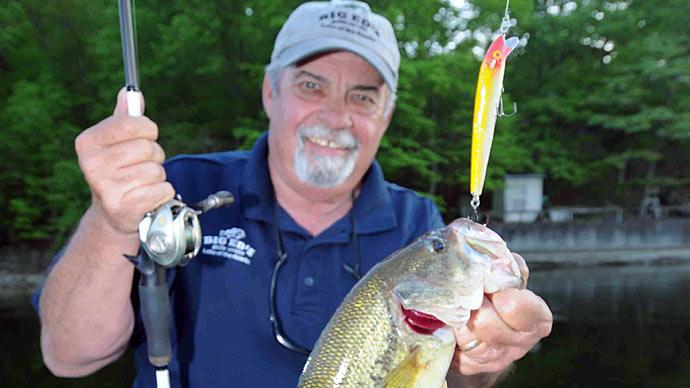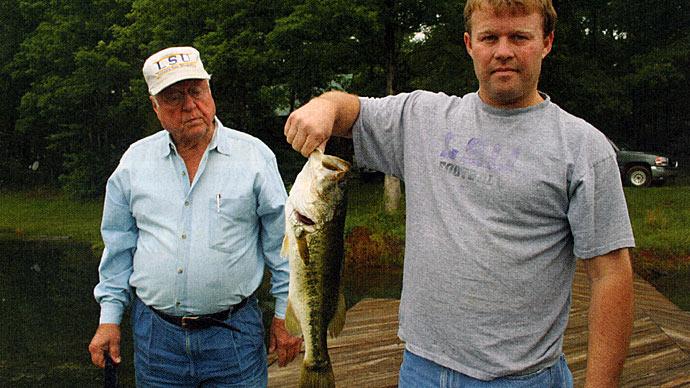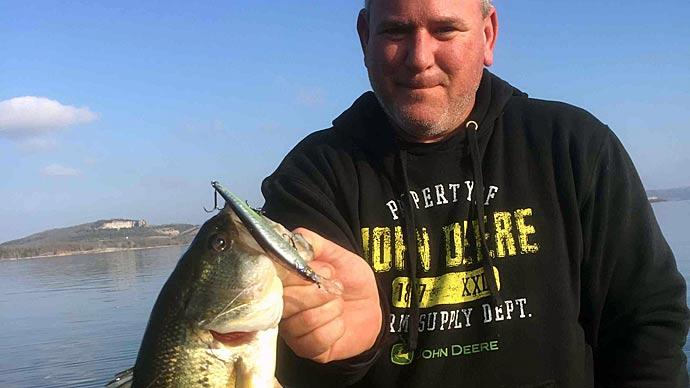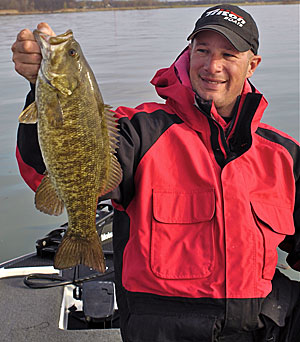
When guide Gerry Gostenik and I pulled into the parking lot at Elizabeth Park at the mouth of the Detroit River, the parking lot was jam-packed with boats and trailers. But it was safe to say that we were probably the only ones fishing for bass.
It was late April, and most anglers had walleyes on their mind. But Gostenik had a gut feeling that we could find some good smallies if we were looking in the right place.
The right place was in a shallow bay behind an island off the main river. The water temperature there was 50 degrees. In the main river, the water temperature was still in the low 40s. Gostenik’s hunch that monster smallies from Lake Erie would be converging on the shallows to pig out turned out to be correct.
A slightly deeper channel led into the bay, and Gostenik explained that the smallies would follow that like a highway as they made their way back into the warmer, shallow bay to hunt. Gostenik shared that the best way to cover water and locate smallies was with a jerkbait. Jerkbaits or stickbaits were perfect for the 3- to 5 feet of water we’d be targeting and were a good match for the shiners, shad, and other baitfish the bass would be hunting for.
Jerkbaits are an excellent choice for cold water because they have lots of action to trigger strikes and can be fished fast or slow. The emphasis was on slow in cold water, like we were fishing. You can catch smallmouths by just casting and retrieving. But you’ll do much better by working the bait with long pauses and finding a cadence that the fish want in cold water that means slow, slower, and slowest.
Gostenik used his electronics to stay on the edge of the channel as we slipped back into the bay and pointed out the contour on the graph. Migrating bass would relate to the channel, and schools of hungry smallies were fanning out into the shallower flats to feed.
Gostenik instructed me to cast as far as possible and work the bait back with short rod sweeps. The idea was to make short, quick rips to make your jerkbait dive to reach the proper depth. The best way to accomplish this is to make short, sharp sweeps from the 3 o’clock to the 5 o’clock position. Many anglers sweep horizontally, which does get the lure as deep. Continue making short sweeps to the boat to keep the lure horizontal in the water column. Each time you rip, you want to hear that distinctive “rattle” that the ball bearings in the lure produce. It’s like ringing the dinner bell to bass.
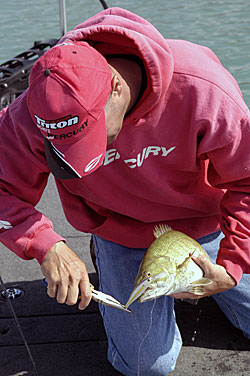
Slack is your friend. Inducing slack before and after your sweep gives your bait an erratic wiggle or stop-and-go action that triggers strikes. Most strikes will occur when you stop and let the lure set. Neutrally buoyant lures will suspend when you pause. Floating lures will begin to swim upwards towards the surface. Find out which the bass want.
Discovering the right cadence is a combination of a quick sweep, slack, and a pause. How long you pause is primarily a function of how cold the water is. It may be a few seconds or up to a half-minute between sweeps. Most of us don’t have the patience to wait that long, but it can be critical to drawing strikes. The colder the water, the longer you should pause. In cold water, a short sweep and pause work much better than a series of twitch-twitch-twitch that would trigger strikes later in the season.
Tackle choice is essential when fishing jerkbaits. Longer rods tend to be the best choice. Longer sticks allow you to make long casts and longer strokes without contacting the water or the side of the boat when you sweep. A medium-power 7-foot casting rod with a softer tip is perfect for manipulating larger jerkbaits and battling bulldogging smallies. A 7-foot spinning combo will be a good choice if you are fishing clear water with smaller baits.
Gostenik is a big fan of Dobyns Rods Model SS703 in either casting or spinning. Load either outfit with a clear 8- to-12-pound test fluorocarbon line. The stiffer fluorocarbon will dissuade the lure from hooking itself. Because it sinks, fluorocarbon will keep your jerkbait down, and its near-invisibility helps draw strikes in the cold, clear spring waters.
Lure size can be a significant factor. Once Gostenik and I started to catch bass, there was a little double that these fish were on the feed. Initially, we missed a lot of fish. Thinking we might not have the lure size or color dialed in, we changed to different brands and sizes. Eventually, we discovered that the short, passive, less aggressive strikes were primarily a function of water temperature. Once the water temperature increased to 54 degrees, most of the bass inhaled the lure regardless of which bait it was. Bass that we caught were regurgitating various sizes of minnows. The bass were just on the munch!
Picking a jerkbait is primarily a function of size and color. Consideration needs to be given to the bait’s lip size and configuration, too. It’s a significant factor in determining the depth you can achieve with the lure and the action. Gerry Gostenik is a big fan of Strike King’s KVD J200 and J300 series jerkbaits. Other stickbaits, like your standard Rattlin’Rogue, Long A Bomber, or Husky Jerk, work.
Fishing got better as the morning went on and temperatures climbed. Most of the bass were between 2 and 4-pounds, but there were several that would scare the heck out of 6-pounds. Giant smallies in anyone’s book! The bass were inhaling the jerkbaits, but we decided to experiment once we’d caught 30 or 40. After all, what respectable smallmouth wouldn‘t eat a tube? The tubes produced some bass and a few bonus walleyes, but it was obvious that jerkbaits were the ticket for spring smallmouths.
BassResource may receive a portion of revenues if you make a purchase using a link above.


